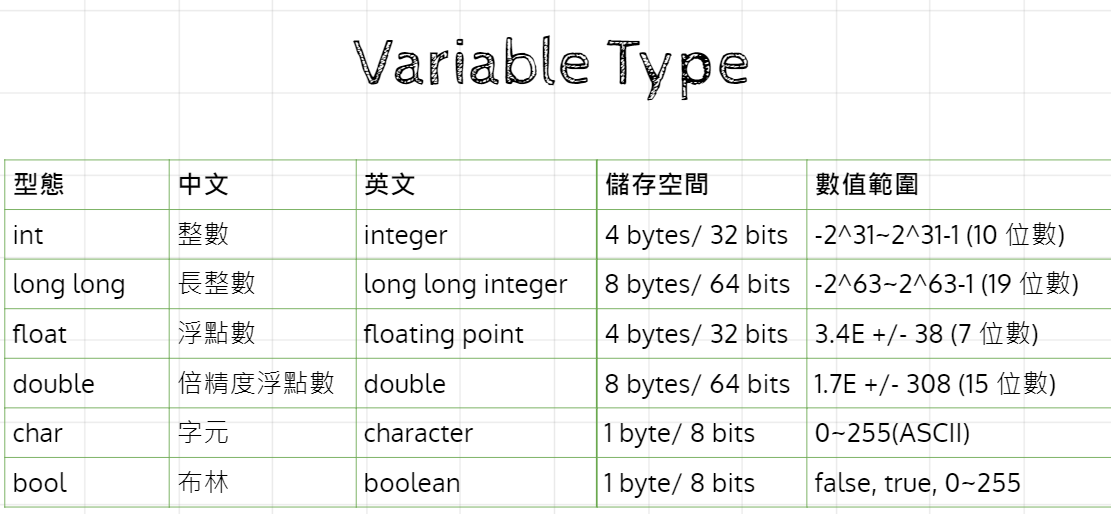Pointer-2
P.s. 此直行為廢話,正文請往右
- 今天的課不太好懂(我也覺得好難)
- 會有多一點思考的時間,和旁邊的好夥伴確認一下程式的意思
- 如果等一下懷疑自己的眼睛看到什麼不要緊張,再看一次會發現怎麼還是那麼詭異😂
大家加油~
深吸一口氣我們就開始囉~

Pointer-1 Review
在經歷段考摧殘後,小小複習一下~
#include <iostream>
using namespace std;
int main(){
int a=10;
int *pointer;
pointer=&a;
cout<<pointer<<'\n'; //0x6ffe14
cout<<*pointer; //10
}- 把 int *看作一個型態,可以儲存int型態變數的地址
- &是取址符號,例如:&a (變數的a的地址)
- * 是取值符號,例如:*pointer (指標pointer的值)
Pointer Array
Array
| 1 | 2 | 3 | 4 | 5 |
|---|
arr[0]
arr[1]
arr[2]
arr[3]
arr[4]
int arr[5]={1,2,3,4,5};Pointer Array
#include <iostream>
using namespace std;
int main()
{
int a[5]={1,2,3,4,5};
cout<<&a<<'\n'; //0x7ffd4b1fff70
cout<<&a[0]<<'\n'; //0x7ffd4b1fff70
return 0;
}陣列指標的地址就是第零格的地址!
Pointer Array
#include <iostream>
using namespace std;
int main(){
int arr[5]={1,2,3,4,5};
for(int i=0;i<5;i++){
cout<<&arr[i]<<' ';//下一張投影片
}
for(int i=0;i<5;i++){
cout<<*arr+i<<' ';//1 2 3 4 5
}
return 0;
}Pointer Array
| 1 | 2 | 3 | 4 | 5 |
|---|
arr[0]
arr[1]
arr[2]
arr[3]
arr[4]
0x6ffe00
0x6ffe04
0x6ffe08
0x6ffe0c
0x6ffe10

欸?是連續的!為什麼差4呢?
1個bit是0或1;1個byte是8個bit
sizeof
如果我們想知道某個東西占幾個byte,我們可以用sizeof()
#include <iostream>
using namespace std;
int main()
{
int arr[100];
cout<<sizeof(int)<<'\n'; //4
cout<<sizeof(double)<<'\n';//8
cout<<sizeof(char)<<'\n';//1
cout<<sizeof(int *)<<'\n';//8
cout<<sizeof(double *)<<'\n';//8
cout<<sizeof(char *)<<'\n';//8
cout<<sizeof(arr)<<'\n';//400
return 0;
}
其實,計算陣列的大小還有下面這個方法
#include <iostream>
using namespace std;
int main(){
int b[]={1,3,5,7,9,11,13,15,17,19,21};
int length=*(&b+1)-b;
cout<<length;
return 0;
}為什麼行得通?
因為+1的單位是&b
&b的單位是int (*) [11]
陣列的名字也是一個指標!?
#include <iostream>
using namespace std;
int main(){
int a[5]={1,2,3,4,5};
cout<<a; //0x7ffd9ddb2f20
cout<<*a;//1
return 0;
}等一下!其實從前面的例子就可以看出這一點了!?
sort
#include <algorithm>
#include <iostream>
using namespace std;
int main(){
int a[5]={10,4,7,2,9};
sort(a,a+5);
for(int i=0;i<5;i++)
cout<<a[i]<<" "; //2 4 7 9 10
return 0;
}
a
a
a+1
a+2
a+3
a+4
a+5
sort(a,a+5)[first, last):包含first,但是不包含last
-->包含a、不包含a+5
Pointer Function
Pass by value
#include<iostream>
using namespace std;
void f(int A, int B) {
int temp = A;
A = B;
B = temp;
cout << A << " " << B <<'\n'; //2 1
}
int main(){
int a = 1, b = 2;
f(a, b);
cout << a << " " << b; //1 2
return 0;
}因為傳到函式裡的東西是副本,所以沒有改到原本的值
Pass by pointer
#include<iostream>
using namespace std;
void f(int *A, int *B) { //A, B是指標型態的參數
int temp = *A; //取A記憶體位址的值,也就是a的值
*A = *B; //把A記憶體位址的值(a),改成B記憶體位址的值(b)
*B = temp; //把B記憶體位址的值(b),改成temp
cout << *A << " " << *B <<'\n'; //2 1
}
int main(){
int a = 1, b = 2;
f(&a, &b); //傳入a, b的記憶體位址
cout << a << " " << b; //2 1
return 0;
}Pass by reference
#include<iostream>
using namespace std;
void f(int &A, int &B) {
int temp = A;
A = B;
B = temp;
cout << A << " " << B <<'\n';//2 1
}
int main(){
int a = 1, b = 2;
f(a, b);
cout << a << " " << b;//2 1
return 0;
}是不是覺得reference 這個詞有點耳熟阿?
在上次的課程中有提到reference就像是取小名的概念


備課冷知識
條列幾個查資料發現的酷東西
- 指標開頭是0x.......,那個0是令解析器可以辨認數,x代表16進位(O代表8進位)
- 大概介紹16進位:規則和10進位、2進位差不多,特別的點是10到15的表示方法,10 : A , 11 : B , 12 : C , 13 : D , 14 : E, 15 : F。舉幾個例子,16是10、28是1C。
- 二維陣列的指標,可以用指標的指標(**),然後c++可以用new得到動態的記憶體。不過小小聲地說…感覺還是vector好用?